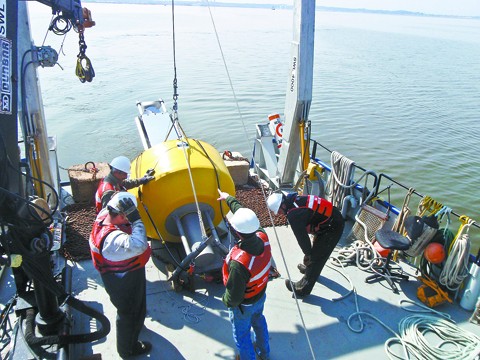AWRI launches floating research center on Muskegon Lake

Courtesy Alan Steinman
Jul 14, 2011
Grand Valley State University’s Annis Water Research Institute launched a floating research center on Apr. 7 to gather data on Muskegon Lake. The buoy, equipped with sensors to monitor several aquatic conditions is a nearly $600,000 project and a partnership among GVSU, the Environmental Protection Agency and the National Oceanic and Atmospheric Administration.
“NOAA is helping to fund the research as is the EPA,” said Scott Kendall, Observatory Manager of the project. “The EPA program financed us through the Great Lakes Restoration Initiative. The buoy acts as a collection center for data on the water.”
Kendall’s partner at AWRI is Bopi Biddanda, the principle investigator of the buoy. Biddanda was unavailable for comment.
The buoy and sensors rest in the center of the lake, just outside of popular shipping lanes. It stands 12 feet tall and is 5 feet in diameter. The main buoy weighs 750 pounds while the two anchors weigh 1,200 pounds each. Each section of chain weighs about 450 pounds. With equipment that size, the buoy was positioned in the water with the assistance of an 80-foot vessel provided by one of AWRI’s partners on the project. Kendall said that the data the buoy collects is helpful to many people outside the research center.
“We’re not hoarding the data,” he said. “Everything we collect goes up on the web and anyone can look at it.”
Kendall said that the data is helpful for research, but it can also be beneficial for fishermen, boaters or hobby scientists.
“This is the first collection center actually on the water,” he said. “If you want to know what the wind is like or the water temperature, we have that information.”
He said the buoy uses a modem to transmit the information from the buoy to the computers at AWRI. The process is very similar to making a cell phone call.
“Muskegon Lake is an area of concern,” he said. “This buoy helps us gather data to study the ecological conditions that cause things like undesirable algae or other beneficial use impairments.”
The information from the buoy is recorded every 15 minutes and transmitted every hour to the computers. From there, the information is sent both to an archive in Allendale and to a database on the web. The data is also quality checked often by inspecting the sensors for malfunctions.
“Anyone can access our data. If a scientist wanted to run his own tests or comparisons, he can use our data. If someone has a sensor they want to use in the Lake, we have a place on our buoy to accommodate them.”
Besides research, AWRI is very proud of the educational and outreach opportunities that the project gives them.
“During the spring and fall, we take students grades six through twelve out on the boat. They get to take samples of the water and compare their findings to the sensor’s findings. Not to mention the community’s opportunity to see what is happening on their lake.”
The boat trips help to get students in West Michigan schools interested in science and to help them gain knowledge of the world around them.
Next week, Kendall said that they hope to launch a new sensor on the buoy, one that will detect water flow speed and direction at several depths. This data could help put the existing data in a new light, especially data on the chlorophyll data that measures the over-saturation of nutrients that can cause an algal bloom.
Once the grant funding runs out in the summer of 2013, AWRI plans to continue the research and perhaps expand it with new funding.
“Once the buoy is out there, that’s a nominal fee,” Kendall said. “However, it transmits on its own. What we fund is maintenance on the sensors.”
The buoy is not an ecological harm to have in the water, but the one drawback is the possibility of a shutdown due to uncontrollable circumstances, such as a lightning strike. However, the researchers at AWRI believe the rewards to greatly outweigh the risk.
To learn more about the project, AWRI or to view the data collected by the buoy, please visit www.gvsu.edu/wri/buoy.





















